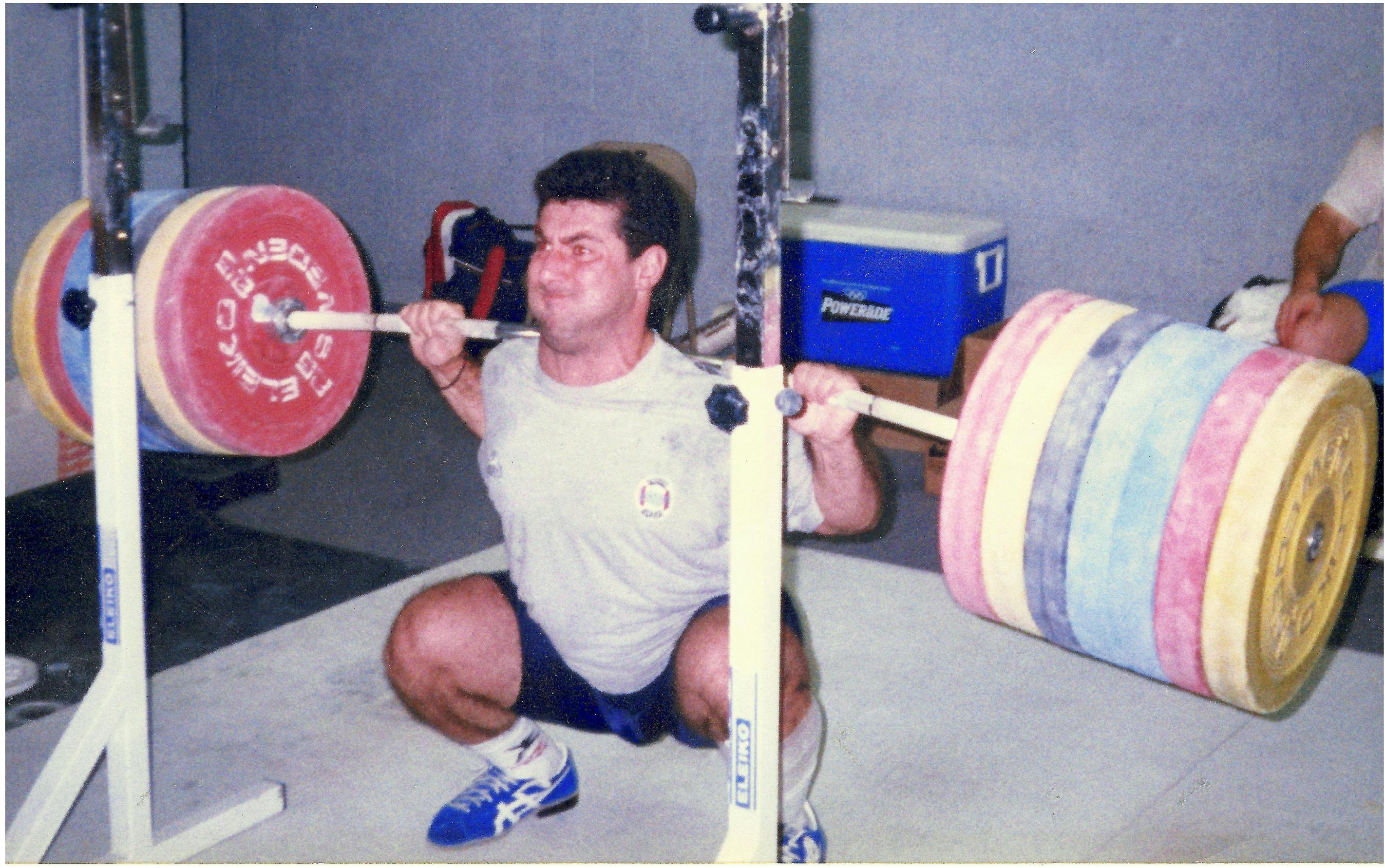http://gawker.com/there-are-some-exercises-you-dont-need-to-do-1504988837
Hamilton states:
Train like hell, you'll get there
Hamilton states:
5 Power Snatches
5 Overhead Squats
Add weight, then…
5 Power Cleans
5 Front Squats
5 Power Jerks
10 Back Squats
10 RDL’s

– 1992, 1996, and 2000 Olympic champion Kakhi Kakhiasvilis performing a squat the way it should be done.
I know that what I am about to write will piss some people off, but I’m an old man, 66, and don’t have anything to lose. I also know that many people will disagree with what I am about to say and it is certainly their right to disagree. What I have to say is only one man’s opinion, but it’s the opinion of a man who’s been around the block a few times with this iron game.
Lately, from several sources, I have noticed that the so called ‘low bar’ squat is being taught as a legitimate way to perform an exercise that many people (myself included) consider to be the best and most productive exercise that can be performed with a barbell. This ‘low bar’ squat style seems to be particularly prevalent in some CrossFit circles. I have also had people show up at my gym performing squats in this style after reading about it in a certain book.
I will start my argument by stating that after well over 50 years as a competitive lifter, coach, and gym owner, I have never seen a top-ranked bodybuilder, Olympic lifter, or serious track or football athlete doing low bar squats.
The squat movement, whether it be high bar full back squats, front squats, half or quarter squats, or Hatfield bar squats, to my mind, should be about developing and strengthening the quadriceps, as well as the glutes. The high bar squat, when done properly, should not involve the hamstrings much at all. These muscles should be developed with straight legged deadlifts and Good Mornings (always with the knees slightly unlocked) as well as the various leg curling and glute ham gastroc movements. The hamstrings are also strongly involved in Olympic lifting movements such as snatches, cleans, and pulls.
I can remember the first powerlifting meet held in Georgia at the old Butler Street YMCA in Atlanta in December 1965. It drew a diverse crew of bodybuilders, Olympic lifters, and men who already considered themselves powerlifters. As one can imagine, all kinds of squat styles were used. A few years later virtually everyone at powerlifting meets were setting up with the bar half way down their deltoids, using a relatively wide foot stance and barely breaking parallel; and this is as it should have been. Squatting in this style allows one to lift the most weight while staying within the parameters of the rules for the squat movement in competition.
In the old days at Coffee’s Gym in the 1980’s, the powerlifters would do high bar squats until about a month out from the competition, at which time they would put on their super suits, widen their foot stance, and set up with the bar half way down their shoulders. Immediately they would squat 100-200 pounds more than they’d been doing on the high bar squat. After the competition they’d go back to their high bar squat routine. Not only did these men become very strong in the squat movement, they also possessed very good quadricep development.
In closing, I would like to say that most trainers should stick to high bar squats, front squats, or squats with the Hatfield bar if it’s strong legs and good quadricep development you seek. If it’s the posterior chain you want to strengthen and develop, stick with Romanian deadlifts, Good Mornings, Olympic lift movements, as well as hyperextensions and various leg curls.
The low bar squat is not an exercise for leg development; it’s a way of doing a strength feat that allows a man or woman to lift the most weight while staying within the rules for the lift, but it’s not a movement that those who wish to develop leg strength for sports or to improve the shape and appearance of their legs has any business doing.
If one wishes to develop real leg strength, every effort should be made to keep the torso upright when squatting. When the torso is inclined forward, much of the effort is transferred to the butt, lower back, and hamstrings. This is not what we want. I would also like to add that all squatting and pulling movements should be performed with the back strongly and rigidly arched. In my opinion the very best test and developer of real leg strength is the full front squat with the back strongly arched. The full high bar squat is not far behind. The low bar back squat is not even on the list.
John B. Coffee
USA Weightlifting Senior International Coach
Edward Baker clean & jerks 165 kg
Leeanna Lim front squats 100 kg for triples
Just fetching a video of Edward power jerking 185 kg/407 lb; this was recorded a few weeks out from the Collegiates this year. 105 kg bodyweight
Just a bit of training from Leeanna Lim and Colleena Collins; they just competed on Saturday so their training is a little laid back this week. Meet video will be soon to follow
Edward Baker has been experimenting with his jerks, and today we recorded him successfully squat jerking 172.5 kg.
Georgia Tech strength coach Zach Reed came in today and did a log press out of the rack with 146 kg/322 lbs. Great job to both lifters!
Today, Megan Murphy of Team Florida Orlando stopped by to train with us! She ended up snatching up to 68 kg and clean & jerking up to 75 kg, 69 kg bodyweight.
After three consecutive misses, Rachel York nails 81 kg. 69 kg bodyweight.